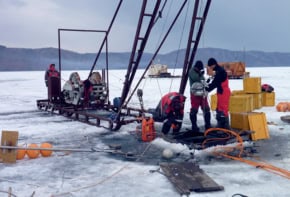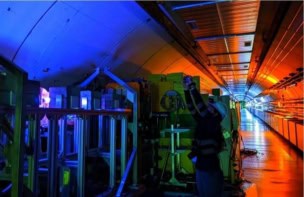Two independent teams of nuclear physicists have found evidence for a new form of radioactivity involving the simultaneous emission of two protons. Researchers at the GANIL laboratory in France and the GSI laboratory in Germany observed two-proton decay using the short-lived isotope iron-45. They say that this form of radioactivity should reveal important information about the structure of the nucleus (J Giovinazzo et al. 2002 Physical Review Letters 89 102501, M Pfutzner et al. 2002 European Physical Journal A14 279).
Nuclei decay when they contain either too many neutrons or too many protons to be stable. In addition to alpha, beta and gamma decay and nuclear fission, certain proton-rich nuclei can also decay by emitting protons. Researchers have already observed nuclei with an odd number of protons decaying through the emission of a single proton.
In the latest research, physicists have observed a type of radioactive decay predicted to occur in heavy nuclei with an even number of protons and/or neutrons. In these nuclei the protons and neutrons are bound together by a “pairing” force, which causes emission of two protons at the same time.
Both research groups fired a beam of nickel-58 ions at a fixed target – at GANIL the target was made of nickel, while the GSI experiment used beryllium. The impact caused the nickel-58 ions to split up into a number of smaller nuclei, including iron-45, which contains 26 protons and 19 neutrons. These nuclei were then separated out from the rest of the impact debris, slowed down and captured in a series of silicon detectors, where they quickly decayed via two-proton emission.
The GANIL researchers observed 12 such decays and the GSI researchers four. In both experiments the energy of the emitted protons had a well-defined value of about 1 mega electronvolt, which agrees well with a number of theoretical models. Results from the two experiments also produced consistent values of the two-proton decay half-life – around 4 milliseconds.
The leader of the French group, Bertram Blank of the Centre for Nuclear Energy Studies in Bordeaux-Gradignan, believes that these results are the first conclusive proof of two-proton radioactivity. Two years ago researchers at Oak Ridge National Laboratory in the US observed two-proton emission from neon-18 nuclei but the half-life of the decay was only about 10-15 s. “In contrast to all previous work, iron-45 has a ‘real’ half-life,” says Blank.
Two-proton decay is a potentially powerful tool for nuclear physicists because it could reveal how protons are bound together in the nucleus. If the protons exist in pairs, then they should be emitted from the iron-45 nucleus as a single nucleus of helium-2 and would therefore be separated by only a very small angle. But if, on the other hand, the protons are independent of one another, they would not have any angular correlation.
Unfortunately, the GANIL and GSI experiments are not currently able to measure the angles at which the individual protons are emitted. To reap the full benefits of this latest discovery, nuclear physicists will have to wait several years while they build new experiments.



